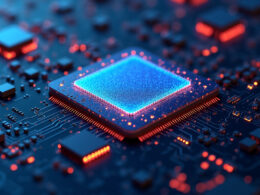In a potential game-changer for enthusiasts and hardcore gamers, AMD is rumored to be working on a groundbreaking addition to its Ryzen lineup. A dual 3D V-Cache Ryzen CPU boasting 192 MB of L3 cache could soon make its debut, challenging existing notions of CPU architecture and performance capabilities.
Zooming In
The Cache Race: Industry Context
The development of CPUs with large caches is part of an ongoing trend towards optimizing processor performance for demanding applications like gaming and professional workloads. AMD and Intel have vied for leadership in the CPU performance race for years. AMD’s use of 3D V-Cache technology, stacked cache layers that significantly increase the total cache available without a proportionate increase in physical size, has set new standards in consumer processor design.
What the Rumors Say
According to an unverified report from a user known as ‘chi11eddog’, AMD might soon integrate 3D V-Cache technology across all Core Complex Dies (CCDs) in an upcoming Ryzen model. This could raise the L3 cache to an unprecedented 192 MB, far beyond existing desktop CPUs. If realized, this would increase the CPU’s total power consumption to about 200 watts, up from the typical 170 watts outputs by comparable models.
Why It Matters
The potential launch aligns with a current market trend where users are willing to invest in high-performance components, evidenced by significant sales in high-end graphics cards such as Nvidia’s RTX 5090, priced over $2,000. Enthusiasts value the smallest performance boosts in compute power and are ready to pay premium prices for cutting-edge hardware. A Ryzen CPU model with a 192 MB L3 cache could fill a niche for users seeking the utmost performance from their PCs.
Technical Perspectives and Comparisons
The anticipated CPU would likely see its greatest benefit in gaming scenarios where cache plays a crucial role by temporarily storing data to quickly feed the processing cores. Unlike standard additions that might cater to broader tasks, this processor would aim to outshine peers by combining two CCDs packed with 3D V-Cache, setting a new performance hallmark.
In the current processor market, the most notable competitor is Intel, which has been exploring similar enhancements with next-generation architecture like the Nova Lake, rumored to emphasize gaming by optimizing cache use.
Implications for AMD and the Market
Should AMD proceed with such a release, it could further solidify its standing as a leader in the gaming CPU sector, raising the stakes for rivals attempting to catch up. At a purported $1,000, the new Ryzen unit would cater to enthusiastic segments looking for minor performance increases that yield a marginal competitive advantage.
Additionally, the move could accelerate developments in software, particularly gaming engines, encouraging optimization to exploit enhanced cache capabilities, fundamentally altering game design paradigms.
What’s Next?
While this development remains speculative, industry enthusiasts and insiders will watch closely for AMD’s official announcements. Successful deployment could prompt shifts in market dynamics, demand structures and inspire future designs in consumer-tier processors.
As consumers await confirmation, the focus will be on how AMD and its competitors balance innovation, cost, and market demand to shape the next chapter of computing. The industry’s trajectory toward incorporating advanced memory-centric performance will undoubtedly define user experience and computational potential in the coming years.









